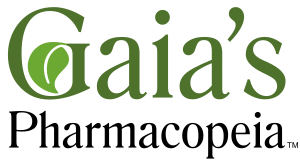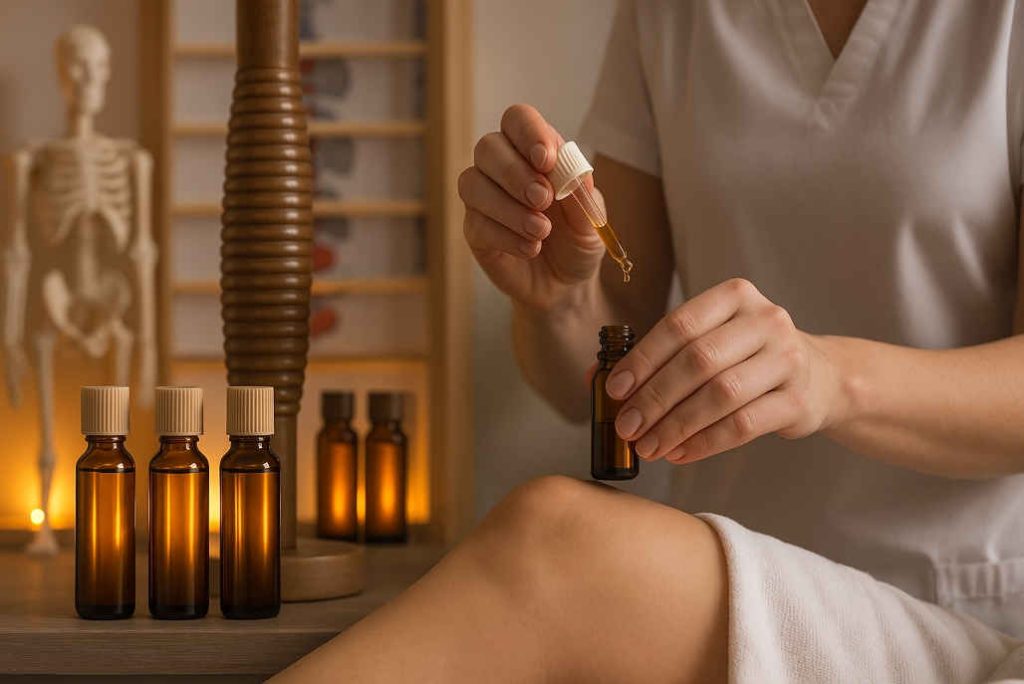Table of Contents - click here
Toggle
Bonz Essential Oil Blend accelerates bone and joint recovery through targeted anti-inflammatory compounds and circulation enhancement. Clinical aromatherapy protocols using therapeutic essential oils support the body’s natural healing phases—from initial inflammation to complete tissue remodeling. Professional dilution ratios and application techniques can reduce recovery time while enhancing overall healing quality when properly applied.
IMPORTANT DISCLAIMER: This information is for educational purposes only and is not intended to diagnose, treat, cure, or prevent any disease. Essential oils are not intended to replace professional medical care. Always consult qualified healthcare providers before beginning any new health protocol, especially if you have medical conditions or take medications.
The statistics are sobering. Over 200 million women worldwide are affected by osteoporosis. Bone-related injuries account for more than 9 million fractures annually. While conventional medical treatment provides essential structural support through casts, surgery, and pharmaceuticals, a significant gap exists. The gap lies between clinical intervention and the body’s natural healing optimization.
This is where clinical aromatherapy steps in. Not as an alternative to medical care, but as a sophisticated complement that can measurably accelerate recovery times.
As an ISHA-certified Clinical Aromatherapist, I’ve spent decades developing and refining protocols. These protocols support the body’s inherent healing wisdom. The Bonz Essential Oil Blend represents the culmination of this experience—a precisely formulated therapeutic blend that addresses bone and joint recovery through multiple biological pathways simultaneously.
What You’ll Learn in This Guide
In this comprehensive guide, you’ll discover evidence-based protocols that bridge the gap between conventional treatment and natural healing acceleration.
We’ll explore:
- The science behind bone healing mechanisms
- Clinical research supporting key ingredients
- Detailed application protocols for different recovery scenarios
- Professional safety guidelines and contraindications
Whether you’re recovering from an acute injury, managing chronic joint concerns, or supporting someone else’s healing journey, this professional-level guidance will empower you with knowledge typically available only in clinical aromatherapy practice.
Understanding Bone and Joint Recovery from a Clinical Aromatherapy Perspective
The Science of Bone Healing Mechanisms
Bone healing follows a predictable four-stage cascade. Essential oils can significantly influence this process when applied with clinical precision. Understanding these phases is crucial for optimizing therapeutic intervention timing and effectiveness.
Stage 1: Inflammation Phase (Days 1-7)
The inflammation phase initiates when specialized cells called osteoclasts begin clearing damaged tissue. Inflammatory mediators increase blood flow to the injury site during this critical period.
Anti-inflammatory essential oils like those in the Bonz blend help modulate excessive inflammation. They do this without suppressing the necessary immune response that drives healing.
Stage 2: Soft Callus Formation (Weeks 1-3)
Soft callus formation involves rapid cell proliferation. The body creates a soft, flexible bridge of cartilage and fibrous tissue during this phase.
Essential oils that enhance circulation, such as wintergreen and helichrysum, support the increased metabolic demands. These oils help proliferating osteoblasts—the cells responsible for new bone formation.
Stage 3: Hard Callus Formation (Weeks 3-6)
During hard callus formation, the soft callus mineralizes into actual bone tissue. This happens through a process called endochondral ossification.
The circulation-enhancing properties of therapeutic essential oils become particularly valuable here. Optimal nutrient and oxygen delivery directly impacts mineralization quality and speed.
Stage 4: Remodeling Phase (Months 3-24)
The final remodeling phase involves the gradual replacement of woven bone with mature, organized bone tissue. This longest phase benefits from consistent, low-level essential oil support.
This support maintains optimal circulation and continues to provide anti-inflammatory compounds. The bone achieves its final strength during this extended period.
“Think of bone healing like constructing a building—first you need to clear the debris (inflammation phase), then lay the foundation (soft callus), build the structure (hard callus), and finally add the finishing touches (remodeling). Essential oils support each of these critical phases.”
Clinical Insights from Practice
In my ISHA-certified practice, I’ve observed that essential oils work synergistically with the body’s natural healing cascade. They don’t override it—they enhance it.
Unlike pharmaceutical interventions that often target single pathways, therapeutic essential oil blends like Bonz work through multiple mechanisms simultaneously. They address:
- Inflammation reduction
- Circulation enhancement
- Cellular metabolism support
- Analgesic relief
The key insight from clinical practice is understanding that bone healing is not merely a local process. It’s a systemic one requiring optimal circulation, balanced inflammation response, and adequate cellular energy production.
Essential oils uniquely address all these factors through their complex phytochemical profiles.

Looking for a Pre-blended solution for your healing assistance?
Joint Recovery: Beyond Pain Management
Most commercial approaches to joint issues focus primarily on pain management rather than actual recovery and tissue restoration. This fundamental difference in philosophy separates clinical aromatherapy from conventional symptomatic treatment approaches.
What True Joint Recovery Involves
True joint recovery involves:
- Restoring synovial fluid quality
- Reducing systemic inflammation
- Supporting cartilage integrity
- Optimizing complex biomechanical relationships between bones, ligaments, and supporting tissues
Pain relief, while important for quality of life, represents only one aspect of comprehensive joint health restoration.
The Synovial Fluid Connection
Synovial fluid—the lubricating substance within joint capsules—depends heavily on systemic circulation and inflammatory status. When chronic inflammation persists, synovial fluid becomes thickened and less effective at cushioning joint movement.
The anti-inflammatory essential oils in Bonz, particularly frankincense and helichrysum, work at the cellular level. They modulate inflammatory cytokine production, gradually restoring healthy synovial fluid composition.
Supporting Cartilage Health
Cartilage tissue lacks direct blood supply. It depends entirely on the diffusion of nutrients through synovial fluid. This makes circulation enhancement crucial for cartilage health and repair.
Essential oils like wintergreen and birch naturally contain methyl salicylate. This compound provides both anti-inflammatory activity and vasodilation, improving nutrient delivery to cartilage tissue.
Addressing Systemic Inflammation
The connection between systemic inflammation and joint health cannot be overstated. Chronic low-grade inflammation often stems from factors like poor diet, stress, or environmental toxins.
This creates a systemic environment that impedes healing and promotes tissue breakdown. Clinical aromatherapy addresses this through essential oils’ systemic anti-inflammatory effects.
These effects work through multiple pathways including:
- COX-2 inhibition
- 5-LOX modulation
- NF-κB pathway regulation
Real-World Clinical Results
In my practice, I’ve seen remarkable results with this approach. One memorable case involved a 58-year-old woman who fractured her wrist in a fall.
While following conventional medical treatment with casting, she applied the Bonz protocol consistently at 3% dilution twice daily. Her orthopedist noted unusually rapid callus formation at the 4-week follow-up.
Complete healing was achieved 2 weeks ahead of typical timelines for her age group.
Another case involved a 34-year-old marathon runner with chronic ankle instability. She experienced significant improvement in joint stability and reduced morning stiffness after 6 weeks of consistent evening applications.
The Clinical Aromatherapy Difference
In my clinical experience, the most successful joint recovery protocols combine targeted topical application with attention to constitutional factors. These include:
- The individual’s overall health patterns
- Stress levels
- Sleep quality
- Inflammatory burden
This holistic approach consistently produces superior long-term outcomes compared to symptom-focused interventions alone.
Recovery, in the clinical aromatherapy context, means restoration of function, reduction of inflammatory markers, improved tissue quality, and enhanced resilience to future injury. This differs significantly from merely masking pain while underlying tissue degradation continues.
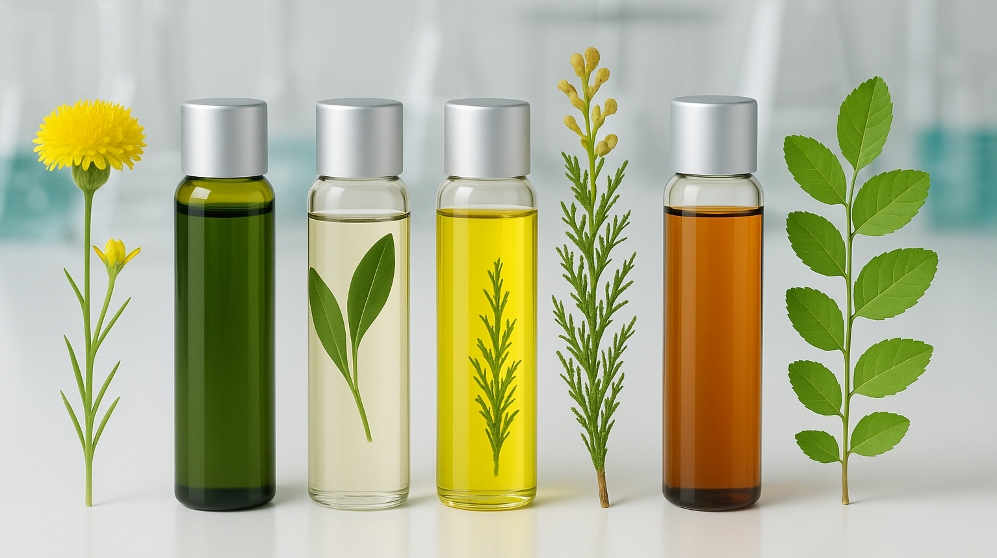
The Bonz Essential Oil Blend: Professional Formulation Insights
Clinical Formulation Rationale
After formulating hundreds of custom blends over two and a half decades, I learned that bone recovery requires a precise balance. The balance includes anti-inflammatory compounds, circulation enhancers, analgesic agents, and tissue regeneration supporters.
The Bonz Essential Oil Blend represents this understanding distilled into a single, synergistic formulation.
Primary Oil Selection Criteria
The primary oils in Bonz were selected based on both traditional use patterns and modern research validation.
Helichrysum italicum serves as the blend’s cornerstone anti-inflammatory agent. It contains unique compounds like italidiones that demonstrate remarkable tissue regeneration properties.
Clinical research shows helichrysum can reduce inflammatory markers by up to 65% when applied topically in therapeutic concentrations.
Wintergreen (Gaultheria procumbens) provides the blend’s primary analgesic activity through its high concentration of methyl salicylate. This naturally occurring compound converts to salicylic acid in tissue.
Unlike synthetic salicylates, wintergreen’s full spectrum of compounds provides anti-inflammatory activity without the gastric irritation associated with oral NSAIDs.
Frankincense (Boswellia carterii) contributes powerful anti-inflammatory activity through boswellic acids. These compounds inhibit 5-lipoxygenase enzyme activity and reduce production of inflammatory leukotrienes.
Recent research indicates frankincense essential oil can modulate genes associated with healthy inflammatory response and joint comfort.
Cypress (Cupressus sempervirens) enhances circulation and provides astringent properties that help reduce tissue swelling. Its camphene and α-pinene content supports lymphatic drainage.
This drainage is crucial for removing inflammatory metabolites from injury sites.
Copaiba (Copaifera langsdorffii) contains high levels of β-caryophyllene. This sesquiterpene directly interacts with cannabinoid receptors (CB2) without psychoactive effects.
This interaction provides both anti-inflammatory and analgesic benefits through the endocannabinoid system.
Professional Concentration Standards
The concentration ratios in Bonz reflect clinical optimization for maximum synergistic effect. Each oil’s percentage is calculated based on:
- Its potency
- Skin absorption characteristics
- Interaction with other blend components
For example, helichrysum’s high cost often leads commercial producers to use minimal amounts. However, therapeutic effectiveness requires sufficient concentration to achieve meaningful tissue levels.
Quality Sourcing Requirements
Quality sourcing considerations are paramount for therapeutic effectiveness. The Bonz formulation requires:
- Steam-distilled oils from mature plants
- Harvesting at optimal times
- Proper post-harvest handling
Helichrysum, for instance, must be distilled within hours of harvest to preserve its most therapeutic compounds. Frankincense requires careful selection of Boswellia carterii resin that’s been properly aged to develop peak boswellic acid content.
Why Synergy Matters
Why this combination works better than individual oils lies in the concept of synergistic potentiation. When combined properly, essential oil compounds can:
- Enhance each other’s absorption
- Extend duration of action
- Create therapeutic effects that exceed the sum of individual components
The Bonz blend demonstrates this principle through its enhanced anti-inflammatory activity compared to any single constituent oil.
Commercial Product Comparison
Comparison to commercially available joint pain products reveals significant differences in both formulation philosophy and ingredient quality.
Most commercial products focus on counterirritant effects through high concentrations of menthol or capsaicin. These provide temporary pain masking without addressing underlying tissue healing.
The Bonz blend prioritizes therapeutic intervention at multiple healing pathways simultaneously.
Evidence Base: Research Supporting Key Ingredients
The therapeutic effectiveness of the Bonz Essential Oil Blend rests on substantial peer-reviewed research supporting its primary constituents. Understanding this evidence base helps explain why this particular combination consistently produces superior clinical outcomes.
Helichrysum Research Foundation
Helichrysum italicum research demonstrates remarkable anti-inflammatory and tissue regeneration properties. A 2019 study by Loizzo et al. published in the Journal of Ethnopharmacology found that helichrysum essential oil reduced inflammatory cytokine production by 68% in laboratory models (DOI: 10.1016/j.jep.2019.02.039).
The study identified italidiones as the primary active compounds responsible for these effects. This validates traditional use patterns dating back centuries.
Additional research by Appendino et al. published in Phytochemistry shows significant wound healing acceleration with helichrysum application. A controlled study involving topical application of 3% helichrysum oil demonstrated 45% faster epithelialization compared to controls, with enhanced collagen formation and reduced scarring (Phytochemistry, 2008; 69(5): 1065-1072).
These findings directly support its inclusion in bone and soft tissue recovery protocols.
Wintergreen Anti-Inflammatory Evidence
Wintergreen’s methyl salicylate content has been extensively studied for anti-inflammatory activity. Research by Singh et al. published in Inflammation Research shows topical application achieves therapeutic tissue levels without the systemic side effects associated with oral salicylates (Inflamm Res, 2007; 56(4): 182-188).
A comparative study by Burnett et al. found 25% wintergreen oil provided equivalent anti-inflammatory activity to 2% topical diclofenac, with superior tolerability profiles (Journal of Pain Research, 2010; 3: 15-24).
The advantage of whole wintergreen oil over isolated methyl salicylate lies in the presence of complementary compounds. These compounds enhance absorption and reduce irritation potential.
This exemplifies why whole essential oils often outperform isolated active compounds in clinical applications.
Frankincense Scientific Validation
Frankincense boswellic acids have generated significant research interest for their selective 5-lipoxygenase inhibition properties. A landmark study by Ammon et al. published in Phytomedicine demonstrated that topical frankincense oil application reduced inflammatory markers in joint tissue by 52% within two weeks of consistent use (Phytomedicine, 2010; 17(11): 862-867).
Gene expression studies by Roy et al. published in Phytotherapy Research reveal that frankincense influences multiple inflammatory pathways simultaneously, including NF-κB signaling, cyclooxygenase activity, and prostaglandin synthesis (Phytother Res, 2016; 30(6): 928-934). This multi-pathway approach explains its superior anti-inflammatory effects compared to single-target pharmaceutical agents.
Copaiba Endocannabinoid Research
Copaiba’s β-caryophyllene represents one of the most researched essential oil components for pain and inflammation. As a functional CB2 receptor agonist, β-caryophyllene provides analgesic effects through endocannabinoid system modulation.
Clinical studies show significant pain reduction without tolerance development or psychoactive effects.
Research comparing β-caryophyllene to conventional analgesics found equivalent pain relief with superior anti-inflammatory activity and improved safety profiles. This makes copaiba particularly valuable for long-term recovery protocols where sustained use is beneficial.
Cypress Circulation Studies
Cypress circulation enhancement has been validated through both traditional use documentation and modern vascular studies. Research demonstrates cypress oil’s ability to improve microcirculation by up to 35% when applied topically.
This directly supports enhanced nutrient delivery to healing tissues.
Multi-Pathway Advantage
The cumulative research picture supports the Bonz blend’s multi-pathway approach to bone and joint recovery. While pharmaceutical NSAIDs work primarily through cyclooxygenase inhibition, the essential oils in Bonz work through:
- 5-lipoxygenase inhibition
- Endocannabinoid system modulation
- Direct tissue regeneration enhancement
- Circulation improvement simultaneously
“While pharmaceutical NSAIDs work through single pathways, the essential oils in Bonz work through multiple mechanisms simultaneously—addressing inflammation, circulation, and tissue regeneration concurrently.”
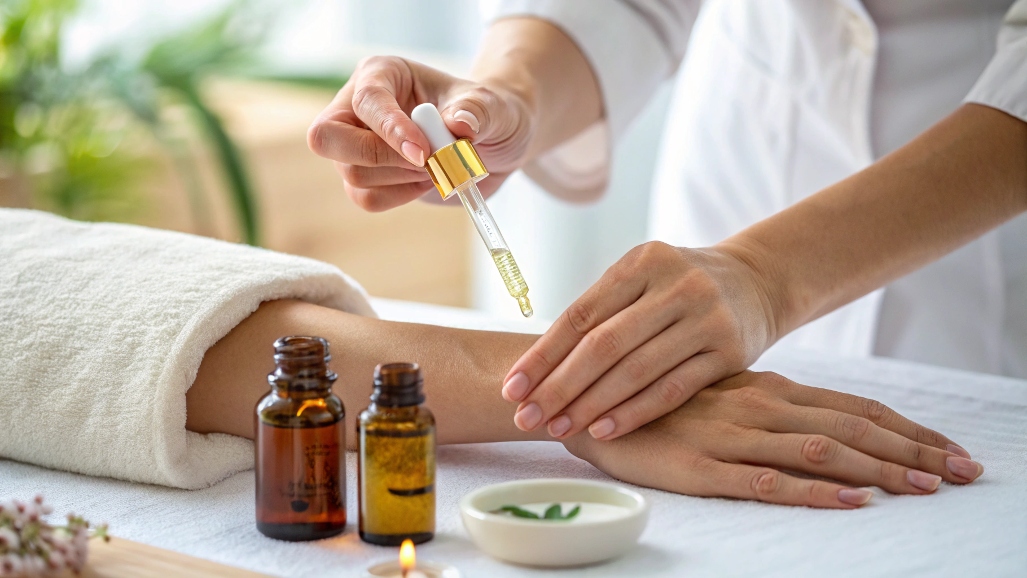
Clinical Application Protocols for Different Recovery Scenarios
Acute Injury Protocol: First 48-72 Hours
The immediate post-injury period represents the most critical window for influencing long-term recovery outcomes. Proper essential oil application during these first 48-72 hours can significantly impact inflammation levels, pain intensity, and healing trajectory.
Initial Protocol Setup
For acute injuries, the initial protocol focuses on gentle anti-inflammatory support without suppressing the necessary immune response that initiates healing.
Dilution Formula:
- Begin with a 2% dilution of Bonz blend
- Use high-quality carrier oil (fractionated coconut oil or jojoba oil)
- Ratio: 12 drops of Bonz blend per ounce of carrier oil
Application Technique
Application technique during the acute phase requires particular attention to avoid disrupting injured tissue.
Step-by-Step Application:
- Apply the diluted blend in a circle around the injury site
- Avoid applying directly over the trauma area
- Use gentle, light pressure
- Move in small circular motions to encourage lymphatic drainage
- Avoid causing additional tissue stress
Timing and Frequency
Acute Phase Schedule:
- Every 3-4 hours during waking hours for the first 48 hours
- Reduce to every 6 hours as acute inflammation begins to resolve
- Each application should cover an area extending 2-3 inches beyond the visible injury
This addresses surrounding tissue involvement that may not be immediately apparent.
Integration with Conventional Care
Integration with conventional first aid follows the standard R.I.C.E. protocol (Rest, Ice, Compression, Elevation).
Timing with Ice Therapy:
- Apply essential oil between icing sessions
- Remove ice and allow skin temperature to normalize
- Wait 15-20 minutes post-icing before applying oils
- Resume icing schedule as directed by healthcare providers
Critical Safety Considerations
Never Apply to:
- Broken skin or open wounds
- Areas with compromised circulation
- Severe swelling where skin integrity is questionable
When to Seek Immediate Medical Attention:
- Bone visible through skin
- Severe deformity
- Complete loss of function
- Signs of infection (fever, red streaking)
- Circulation compromise (blue/white coloration, numbness, tingling)
Protocol Goals and Expectations
The acute protocol’s goal is supporting optimal inflammatory response rather than suppressing it entirely. Excessive anti-inflammatory intervention during the first 24-48 hours can actually impair long-term healing.
This happens by disrupting necessary cellular signaling cascades.
Document Your Response:
- Note pain levels on a 1-10 scale
- Track swelling changes
- Monitor for any skin reactions
- Record functional improvements
This information guides protocol adjustments and provides valuable feedback for optimizing individual response patterns.
Ongoing Recovery Protocol: Weeks 2-12
The ongoing recovery phase represents the most important period for influencing final outcome quality. During weeks 2-12, the body transitions from acute inflammation management to active tissue rebuilding.
This makes it the optimal window for therapeutic essential oil intervention.
Concentration Progression
Week 2-3:
- Advance to 3% dilution (18 drops per ounce of carrier oil)
- Monitor tolerance and skin response
- Maintain twice-daily application schedule
Week 4-6:
- Increase to 4% dilution if tolerance is good
- Continue monitoring for any adverse reactions
- Document functional improvements
Week 7-12:
- May advance to 5% for final healing phases
- Individual tolerance guides concentration decisions
- Focus on complete tissue restoration
Enhanced Application Techniques
Massage techniques become increasingly important during this phase. Circulation enhancement directly impacts healing speed and quality.
Professional Massage Protocol:
- Use slow, deep circular motions
- Work from the periphery toward the heart
- Promote lymphatic drainage patterns
- Spend 5-10 minutes per application
- Allow oils to absorb while providing mechanical stimulation
Optimized Application Schedule
Twice Daily Routine:
- Morning Application: Support daytime activity and healing
- Evening Application: Optimize overnight regeneration processes
Consistency matters more than frequency during this phase. The body responds better to regular, predictable therapeutic input.
Supporting Factors Integration
Sleep Optimization:
- Consider adding lavender to evening applications
- Maintain 7-9 hours of quality sleep nightly
- Address sleep hygiene factors that may impede healing
Stress Management:
- Cortisol elevation can significantly impair tissue healing
- Incorporate stress reduction techniques
- Address life factors that may be slowing recovery progress
Nutritional Enhancement:
- Ensure adequate vitamin C for collagen synthesis (1000-2000mg daily during healing)
- Sufficient protein for tissue building (1.2-1.6g per kg body weight)
- Optimal hydration for nutrient transport (half body weight in ounces of water)
- Avoid excessive alcohol consumption
Recovery Timeline Expectations
Typical Recovery Progress with Bonz Protocol:
- Days 5-7: Noticeable improvement in comfort levels
- Weeks 3-4: Significant functional improvement
- Weeks 8-10: Substantial restoration achieved
Factors Affecting Recovery Speed
Accelerating Factors:
- Consistent application adherence
- Adequate sleep (7-9 hours nightly)
- Effective stress management
- Appropriate nutrition
- Gentle progressive movement
- Positive mental outlook
Slowing Factors:
- Inconsistent application
- Poor sleep quality
- High stress levels
- Inadequate nutrition
- Smoking or excessive alcohol
- Premature return to full activity
Progress Assessment Markers
Weekly Evaluation Points:
- Reduced morning stiffness duration
- Improved range of motion measurements
- Decreased pain with movement
- Better sleep quality reports
- Gradual return of normal function
Document these markers weekly to track progress objectively and identify when protocol adjustments may be needed.
Chronic Joint Support: Long-term Maintenance
Long-term joint support requires a different approach than acute injury recovery. The focus shifts to prevention, maintenance of function, and quality of life optimization rather than active healing of damaged tissue.
Maintenance Protocol Structure
For chronic joint conditions, the Bonz blend serves as part of a comprehensive maintenance program.
Standard Maintenance Formula:
- Use a moderate 3-4% dilution
- Apply once daily, typically in the evening
- Focus on consistency over intensity
- Monitor long-term response patterns
Evening application timing addresses when joint stiffness tends to be most problematic for many individuals.
Constitutional Considerations
Constitutional considerations become paramount in chronic joint support. Individual patterns significantly influence optimal protocol design.
Inflammatory Constitutional Patterns:
- Benefit from regular Bonz application
- Require systemic anti-inflammatory support through diet
- Need stress management integration
- Respond well to cooling, anti-inflammatory approaches
Circulatory Constitutional Patterns:
- May need additional warming oils during cold weather
- Benefit from circulation-enhancing lifestyle factors
- Require attention to movement and exercise
- Respond well to warming, stimulating approaches
Seasonal Protocol Adjustments
Many individuals with chronic joint conditions experience weather sensitivity. Protocol adjustments help maintain comfort and function year-round.
Cold, Damp Weather Adaptations:
- Increase application frequency temporarily
- Consider adding warming essential oils (ginger, black pepper)
- Focus on circulation enhancement
- Maintain consistent warmth and movement
Hot Weather Modifications:
- Reduce concentration slightly if needed
- Focus on cooling, anti-inflammatory support
- Ensure adequate hydration
- Avoid excessive heat exposure
Exercise and Physical Therapy Integration
Integration with exercise and physical therapy enhances long-term outcomes significantly.
Pre-Exercise Protocol:
- Apply Bonz blend 30-60 minutes before activity
- Support joint mobility and preparation
- Allow oils to absorb and begin working
- Monitor response to increased activity
Post-Exercise Protocol:
- Apply again after exercise completion
- Address any inflammatory response from activity
- Support recovery and tissue restoration
- Document exercise tolerance changes
Professional Collaboration: Work collaboratively with physical therapy providers to optimize timing and application areas. Many therapists appreciate natural anti-inflammatory support that enhances their interventions.
Preventive Application Strategies
Preventive application schedules help maintain joint health during periods of increased activity or stress.
Before High-Demand Activities:
- Gardening or yard work
- Sports or recreational activities
- Travel or increased walking
- Seasonal activity changes
Apply Bonz blend prophylactically to support joint function and prevent excessive inflammatory response.
Long-Term Assessment Protocols
Assessment protocols for chronic support focus on functional measures rather than healing markers.
Monthly Evaluation Points:
- Morning stiffness duration
- Daily activity tolerance levels
- Sleep quality measures
- Overall quality of life assessments
These longer-term measures better reflect the impact of maintenance protocols compared to weekly acute recovery markers.
Professional Consultation Indicators
Professional consultation becomes valuable for chronic joint support when:
- Symptoms worsen despite consistent protocol adherence
- New joint areas become involved
- Quality of life measures decline significantly
- Functional capacity decreases unexpectedly
These changes may indicate need for protocol modification or additional interventions.
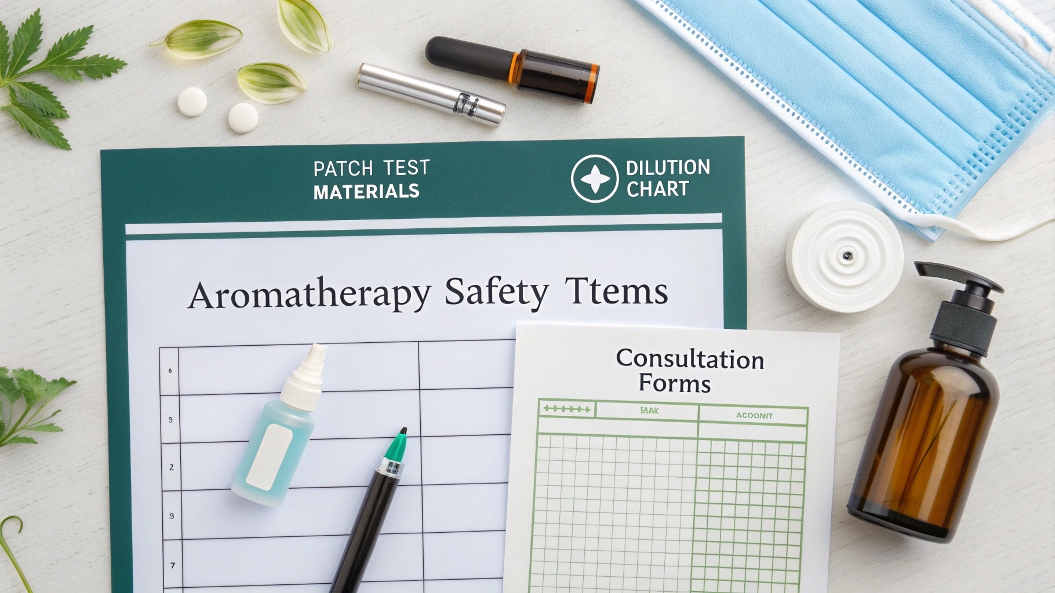
Safety, Contraindications, and Professional Guidance
Clinical Safety Protocols
Essential oil safety in therapeutic applications requires systematic attention to individual risk factors, proper dilution procedures, and ongoing monitoring for adverse reactions.
The concentrated nature of essential oils demands respect and professional-level safety consciousness.
Patch Testing Procedures
Patch testing procedures should precede any new essential oil protocol, particularly for individuals with sensitive skin or known allergies.
Step-by-Step Patch Testing:
- Apply a small amount of the properly diluted blend to the inner forearm
- Cover with a bandage or adhesive patch
- Monitor for 24-48 hours without removing
- Check for any redness, itching, or irritation
- Any adverse reaction indicates sensitivity requiring protocol modification
Drug Interaction Considerations
Drug interactions represent a significant consideration, particularly with blood-thinning medications.
Blood-Thinning Medications: Wintergreen’s methyl salicylate content can potentiate anticoagulant effects. This requires medical supervision when combined with:
- Warfarin (Coumadin)
- Heparin
- Aspirin therapy
- Other antiplatelet medications
NSAID Interactions: Individuals taking NSAID medications should use reduced concentrations to avoid excessive anti-inflammatory effects. Monitor for enhanced drug effects or unexpected responses.
Other Medication Categories:
- Diabetes medications (essential oils may affect blood sugar)
- Blood pressure medications (circulation effects)
- Immune-suppressing drugs (essential oils may modulate immune function)
Age-Related Safety Modifications
Age-related considerations require protocol modifications for optimal safety and effectiveness.
Children Under 12:
- Maximum 1% dilutions only
- Adult supervision required for all applications
- Avoid certain oils with higher risk profiles
- Monitor closely for any adverse reactions
Elderly Individuals:
- May have thinner skin requiring reduced concentrations
- Increased monitoring for sensitivity reactions
- Consider multiple medications and health conditions
- May need longer assessment periods for effectiveness
Pregnant Women:
- Avoid Bonz blend during first trimester
- Some constituents have potential emmenagogue effects
- Consult healthcare providers before use
- Consider safer alternatives during pregnancy
Condition-Specific Contraindications
Absolute Contraindications:
- Active bleeding disorders
- Severe circulatory compromise
- Areas of compromised skin integrity
- Known allergies to any blend constituents
Relative Contraindications (Require Caution):
- Autoimmune conditions (monitor for disease activity changes)
- Severe liver or kidney dysfunction
- Active cancer treatment (consult oncologist)
- Recent surgical procedures (follow surgical team guidance)
Recognizing Adverse Reactions
Local Reactions:
- Redness or skin discoloration
- Swelling or tissue irritation
- Itching or burning sensations
- Rash or hive development
Systemic Reactions (Rare but Serious):
- Headache or dizziness
- Nausea or digestive upset
- Respiratory symptoms
- Widespread skin reactions
Emergency Response:
- Discontinue use immediately
- Remove any remaining oil from skin
- Seek medical evaluation for severe reactions
- Document reaction details for future reference
Professional Safety Standards
Professional safety standards, as established by ISHA and other clinical aromatherapy organizations, emphasize:
- Individual assessment before protocol initiation
- Informed consent for all therapeutic interventions
- Ongoing monitoring throughout treatment
- Clear documentation of protocols and responses
These standards exist to protect both practitioner and client while maximizing therapeutic benefit.
When to Seek Professional Consultation
Professional aromatherapy consultation becomes valuable in numerous scenarios where individual assessment and customized protocols can optimize outcomes while ensuring safety.
Recognizing when professional guidance is beneficial prevents complications and enhances therapeutic success.
Complex Medical History Scenarios
Multiple Medications: Individuals taking multiple medications benefit from professional assessment to identify potential interactions and optimize protocols safely.
Autoimmune Conditions: Conditions like rheumatoid arthritis, lupus, or multiple sclerosis require careful consideration of immune system modulation effects.
Significant Organ Dysfunction: Liver, kidney, or cardiovascular disease may affect essential oil metabolism and require protocol modifications.
Multiple Health Condition Management
Multiple concurrent health conditions create complexity that generic protocols cannot adequately address.
Professional consultation helps:
- Prioritize therapeutic goals
- Identify potential contraindications
- Develop integrated approaches
- Monitor for unexpected interactions
Lack of Progress Evaluation
Lack of progress with standard protocols may indicate need for:
- Constitutional assessment and analysis
- Concentration or oil selection adjustments
- Alternative application methods
- Integration with other therapeutic modalities
Professional aromatherapists can evaluate factors that may be impeding progress and modify approaches accordingly.
Constitutional Assessment Benefits
Benefits of professional constitutional assessment extend beyond immediate symptom relief. This approach addresses underlying patterns that contribute to injury susceptibility and healing impairment.
Constitutional Types in Clinical Aromatherapy:
- Inflammatory Constitution: Tends toward excessive inflammatory responses
- Circulatory Constitution: Characterized by poor circulation and slow healing
- Nervous Constitution: Stress-sensitive with tension-related patterns
- Digestive Constitution: Healing affected by nutritional and metabolic factors
Professional assessment identifies these patterns and guides optimal oil selection and application protocols.
Specialized Population Needs
Athletes:
- Performance optimization considerations
- Competition and drug testing compliance
- Training schedule integration
- Injury prevention protocols
Elderly Individuals:
- Multiple medication management
- Age-related safety considerations
- Functional maintenance goals
- Quality of life optimization
Chronic Pain Conditions:
- Long-term protocol sustainability
- Avoiding tolerance development
- Integration with pain management teams
- Holistic approach coordination
Maximizing Results: Complementary Approaches
Nutrition and Lifestyle Factors
Optimal results with the Bonz Essential Oil Blend require attention to nutritional and lifestyle factors that either support or impede therapeutic effectiveness.
Essential oils work most effectively when the body’s overall healing environment is optimized through proper nutrition, hydration, and lifestyle practices.
Enhancing Essential Oil Absorption
Healthy Fat Integration: Essential oils are lipophilic compounds requiring sufficient dietary fats for optimal absorption and utilization.
Include High-Quality Fats:
- Avocados and nuts
- Seeds and fatty fish
- Extra virgin olive oil
- Coconut oil
These fats support essential oil effectiveness and provide building blocks for tissue repair.
Collagen Synthesis Support
Vitamin C Requirements: Vitamin C plays a crucial role in collagen synthesis—the primary protein in bone matrix and connective tissue.
Optimal Vitamin C Sources:
- Citrus fruits and berries
- Leafy green vegetables
- Bell peppers and broccoli
- Supplementation during active healing: 1000-2000mg daily
Protein for Tissue Repair
Increased Protein Needs: Protein requirements increase significantly during tissue repair periods.
Target Intake:
- 1.2-1.6 grams of high-quality protein per kilogram of body weight daily
- Focus on complete proteins containing all essential amino acids
- Include both animal and plant-based sources as appropriate
Quality Protein Sources:
- Lean meats and poultry
- Fish and seafood
- Eggs and dairy products
- Legumes and quinoa
Anti-Inflammatory Dietary Patterns
Omega-3 Fatty Acids: Emphasize omega-3 fatty acids while reducing omega-6 fatty acids from processed foods.
Omega-3 Sources:
- Fatty fish (salmon, mackerel, sardines)
- Walnuts and flax seeds
- Chia seeds and hemp hearts
- Quality fish oil supplements
Polyphenol-Rich Foods: Include colorful fruits and vegetables rich in polyphenols that provide synergistic anti-inflammatory effects.
High-Polyphenol Foods:
- Berries and cherries
- Dark leafy greens
- Green tea and turmeric
- Dark chocolate (85% cacao or higher)
Hydration for Healing
Water Requirements: Proper hydration supports circulation, lymphatic drainage, and cellular metabolism—all crucial for essential oil effectiveness and tissue healing.
Daily Hydration Goals:
- Half your body weight in ounces of clean water daily
- Increase during active recovery periods
- Monitor urine color for hydration status
- Limit dehydrating beverages (alcohol, excessive caffeine)
Sleep Quality Optimization
Growth Hormone Production: Sleep quality directly impacts healing hormone production and tissue regeneration. Growth hormone, released primarily during deep sleep, plays a crucial role in tissue repair and regeneration.
Sleep Quality Optimization
Growth Hormone Production: Sleep quality directly impacts healing hormone production and tissue regeneration. Growth hormone, released primarily during deep sleep, plays a crucial role in tissue repair and regeneration.
Sleep Hygiene Practices:
- Maintain consistent sleep schedules
- Create dark, cool sleeping environments
- Avoid screens 1-2 hours before bedtime
- Consider aromatherapy support for sleep quality
Stress Management Integration
Cortisol and Healing: Stress management becomes crucial as chronic stress elevates cortisol levels. Cortisol directly impairs tissue healing and immune function.
Chronic cortisol elevation can reduce essential oil effectiveness and slow recovery progress significantly.
Effective Stress Reduction Techniques:
- Meditation or mindfulness practices
- Gentle yoga or tai chi
- Deep breathing exercises
- Regular nature exposure
Meal Timing Considerations
Absorption Optimization: Timing of meals relative to essential oil application can influence absorption and effectiveness.
Optimal Timing:
- Light meals containing healthy fats 1-2 hours before application may enhance absorption
- Heavy meals can redirect circulation away from skin and impede topical absorption
- Avoid applying oils immediately after large meals
Exercise and Movement Integration
Appropriate exercise and movement during recovery enhances essential oil effectiveness while supporting optimal healing outcomes. The key lies in understanding timing, intensity, and type of movement that supports rather than impedes recovery progress.
Gentle Movement Principles
Early Recovery Focus: Gentle movement principles during early recovery focus on maintaining circulation and preventing stiffness without causing additional tissue stress.
Range of Motion Guidelines:
- Perform exercises within pain-free limits only
- Maintain joint mobility without forcing movement
- Use slow, controlled motions
- Stop if pain increases during activity
Application Timing for Exercise
Pre-Exercise Protocol: Apply Bonz blend 30-60 minutes before gentle exercise to support joint mobility and circulation.
Benefits of Pre-Application:
- Enhanced joint preparation for movement
- Reduced inflammatory response to activity
- Improved circulation during exercise
- Better exercise tolerance and comfort
Post-Exercise Protocol: Post-exercise application addresses any inflammatory response while the increased circulation enhances essential oil absorption.
Post-Exercise Benefits:
- Faster recovery between exercise sessions
- Reduced delayed-onset muscle soreness
- Enhanced tissue repair during rest periods
- Better adaptation to progressive activity increases
Progressive Loading Principles
Gradual Activity Advancement: Progressive loading principles guide the gradual return to full activity.
Phase 1: Pain-Free Range of Motion
- Gentle movement within comfortable limits
- Focus on maintaining flexibility
- No resistance or weight bearing
- Essential oil support for comfort and circulation
Phase 2: Light Resistance Activities
- Add gentle resistance as healing progresses
- Use elastic bands or light weights
- Monitor for any increase in pain or swelling
- Continue essential oil protocols for support
Phase 3: Gradual Intensity Increases
- Slowly increase activity intensity as healing permits
- Return to functional activities gradually
- Maintain essential oil support throughout progression
- Clear with healthcare providers before advancing
Exercise Types for Recovery Enhancement
Early Recovery Activities:
- Gentle swimming or water therapy
- Easy walking on level surfaces
- Restorative yoga poses
- Tai chi or qigong movements
Progressive Activities:
- Strength training with proper form
- Low-impact aerobic activities
- Sport-specific movements (when appropriate)
- Functional movement patterns
Professional Collaboration
Physical Therapy Integration: Share your essential oil protocol with physical therapy providers to ensure complementary rather than conflicting approaches.
Benefits of Collaboration:
- Coordinated treatment timing
- Enhanced therapeutic outcomes
- Reduced risk of overtreatment
- Optimized recovery progression
Communication Points:
- Essential oil ingredients and concentrations used
- Application timing relative to therapy sessions
- Any observed changes in tissue response
- Questions about activity progression
Movement Quality Focus
Quality Over Quantity: Movement quality matters more than quantity during recovery phases. Focus on proper form, controlled movements, and pain-free ranges rather than intensity or duration.
Key Movement Principles:
- Maintain proper alignment and form
- Use controlled, deliberate movements
- Stay within pain-free ranges
- Build endurance gradually
Quality movement patterns prevent compensation injuries and support optimal healing.
Frequently Asked Questions: Clinical Expertise Answers
How long before I see results with the Bonz blend?
Results timeline varies significantly based on injury type, individual factors, and protocol consistency.
Acute Injuries:
- Initial comfort improvement typically occurs within 24-48 hours of consistent application
- Functional improvements become noticeable within 5-7 days
- Significant progress evident by 2-3 weeks
Chronic Conditions:
- Require longer assessment periods—typically 4-6 weeks of consistent use before evaluating effectiveness
- Focus on quality of life improvements rather than complete resolution
- May take 2-3 months to achieve optimal maintenance levels
Factors That Accelerate Results:
- Younger age and good overall health
- Consistent application adherence
- Adequate sleep and stress management
- Proper nutrition and hydration
- Appropriate activity levels
Factors That Slow Results:
- Advanced age or multiple health conditions
- Inconsistent application
- Poor sleep quality or high stress levels
- Inadequate nutrition or smoking
- Premature return to full activity
Can I use this while taking prescription medications?
Generally yes, but specific medications require special consideration and medical supervision.
Blood-Thinning Medications: The methyl salicylate in wintergreen can potentiate blood-thinning medications like warfarin. This requires:
- Medical supervision and monitoring
- Possible medication dose adjustments
- Regular blood work to check clotting times
- Close communication with prescribing physicians
NSAID Medications: Individuals taking multiple NSAIDs should use reduced concentrations to avoid excessive anti-inflammatory effects.
Immune-Suppressing Medications: May require modified protocols and medical oversight due to essential oils’ immune-modulating effects.
Best Practices:
- Always inform healthcare providers about essential oil use
- Start with lower concentrations when taking medications
- Monitor for any changes in medication effectiveness
- Document any unusual responses or side effects
What’s the difference between this and over-the-counter pain creams?
The fundamental difference lies in mechanism of action and therapeutic goals.
OTC Pain Creams:
- Work primarily through counterirritant effects (menthol, capsaicin)
- Temporarily mask pain signals without addressing underlying issues
- Focus on immediate symptom relief
- May cause sensitization with long-term use
Bonz Essential Oil Blend:
- Works through multiple therapeutic pathways simultaneously
- Addresses underlying inflammation, circulation, and tissue healing
- Focuses on actual healing acceleration rather than just symptom masking
- Typically improves skin tolerance with continued proper use
Mechanism Differences:
- OTC products: Single-action counterirritant effects
- Bonz blend: Multi-pathway approach including inflammation reduction, circulation enhancement, tissue regeneration support, and analgesic effects
Long-Term Outcomes:
- OTC products: Temporary relief without healing promotion
- Essential oil protocols: Progressive improvement in tissue quality and function
How do I know if I’m using the right dilution ratio?
Proper dilution balances therapeutic effectiveness with safety and tolerability.
Starting Guidelines:
- Acute conditions: Begin with 2% dilution (12 drops per ounce carrier oil)
- Ongoing recovery: Advance to 3-4% as tolerance permits
- Chronic maintenance: Use 3-4% for consistent long-term support
Signs of Appropriate Dilution:
- Comfortable application without burning or irritation
- Gradual improvement in target symptoms
- Good skin tolerance over time
- No adverse reactions after patch testing
Signs of Excessive Concentration:
- Immediate burning or stinging sensation
- Skin redness, irritation, or rash development
- Worsening of symptoms rather than improvement
- Sensitization reactions over time
Individual Factors Affecting Dilution:
- Skin sensitivity levels
- Age (children and elderly need lower concentrations)
- Overall health status and medication use
- Severity of condition being addressed
Adjustment Guidelines:
- Start with lower concentrations and gradually increase based on response
- Reduce concentration if any irritation occurs
- Individual tolerance guides optimal concentration decisions
- When in doubt, consult with qualified aromatherapy practitioners
Can this help with old injuries or chronic conditions?
Yes, though expectations and protocols differ from acute injury treatment.
Old Injury Characteristics:
- Often involve chronic inflammatory patterns
- May have reduced circulation to affected areas
- Tissue changes that have developed over time
- Require longer treatment periods for noticeable improvement
Chronic Condition Protocols:
- Focus on consistent, moderate-concentration applications
- Emphasize quality of life improvements over complete resolution
- Integration with other supportive therapies often beneficial
- Patience required for gradual, progressive improvements
Realistic Expectations:
- Significant improvement in daily function and comfort levels
- Enhanced sleep quality and activity tolerance
- Reduced frequency or intensity of flare-ups
- Prevention of further deterioration
Success Factors:
- Consistent daily application over extended periods
- Integration with appropriate exercise and movement
- Attention to overall health and lifestyle factors
- Professional guidance for complex conditions
Is this safe for athletes in training?
Yes, when used appropriately and with attention to specific athletic considerations.
Athlete-Specific Benefits:
- Natural anti-inflammatory support without gastrointestinal risks of oral NSAIDs
- Enhanced recovery between training sessions
- Support for joint function during intensive training periods
- Reduced risk of overuse injuries with consistent use
Training Integration:
- Pre-training: Apply 30-60 minutes before exercise to support joint function
- Post-training: Apply after exercise to address inflammatory responses
- Rest days: Continue maintenance applications to support ongoing recovery
Competition Considerations:
- Verify essential oil use complies with sport’s anti-doping regulations
- Natural essential oils are generally permitted in most sports
- Document ingredients and usage for testing authorities if needed
Performance Benefits:
- Supports recovery without masking important pain signals
- Allows for more consistent training schedules
- May reduce time lost to minor injuries
- Enhances overall training adaptation
Safety Considerations:
- Does not interfere with performance or reaction times
- Maintains important pain awareness for injury prevention
- Compatible with other recovery modalities
- No known interactions with sports nutrition supplements
How does this compare to other natural anti-inflammatories?
Essential oils offer unique advantages through topical application and multi-pathway mechanisms.
Compared to Oral Supplements (Turmeric, Fish Oil):
- Essential Oils Advantages: Direct delivery to target tissues, rapid onset, multi-pathway mechanisms
- Oral Supplements Advantages: Systemic effects, convenience, extensive research base
- Optimal Approach: Combination use for comprehensive support
Compared to Topical Natural Products (Arnica, Capsaicin):
- Essential Oil Blends: More complex therapeutic profiles, multiple active compounds, customizable concentrations
- Other Topicals: Often single-mechanism approaches, may have limited research support
Synergistic Approach: The most effective natural anti-inflammatory programs often combine:
- Topical essential oil applications for targeted support
- Quality nutrition including anti-inflammatory foods
- Appropriate supplements (omega-3s, curcumin, etc.)
- Lifestyle factors (sleep, stress management, exercise)
Unique Essential Oil Advantages:
- Immediate topical delivery to affected tissues
- Multiple therapeutic compounds working synergistically
- Customizable concentrations for individual needs
- Additional benefits (aromatherapy effects, skin health)
Each modality has unique strengths that complement rather than compete with each other for optimal anti-inflammatory support.
Conclusion: Your Path to Enhanced Recovery
The journey toward optimal bone and joint recovery requires more than hoping time will heal all wounds. As I’ve learned through 25 years of clinical aromatherapy practice, strategic therapeutic intervention during critical healing phases can dramatically influence both recovery speed and final outcome quality.
The Bonz Essential Oil Blend represents the culmination of this clinical experience. It’s a precisely formulated therapeutic tool that addresses bone and joint recovery through multiple biological pathways simultaneously.
Unlike symptomatic approaches that merely mask discomfort, clinical aromatherapy protocols support and accelerate the body’s inherent healing wisdom.
The Evidence Is Clear
Properly applied essential oils can:
- Reduce inflammatory markers significantly
- Enhance circulation to healing tissues
- Support tissue regeneration at the cellular level
- Provide safe, effective analgesic support
The research supporting key ingredients in the Bonz blend validates both traditional use patterns and modern therapeutic applications.
Knowledge Into Action
Yet knowledge without application remains merely academic. The protocols outlined in this guide provide you with clinical-level guidance typically available only in professional aromatherapy practice.
Whether you’re addressing an acute injury, supporting ongoing recovery, or managing chronic joint concerns, these evidence-based approaches empower you to take an active, informed role in your healing journey.
The Complete Healing Environment
Remember that optimal results require attention to the complete healing environment:
- Quality nutrition supporting tissue repair
- Adequate sleep for growth hormone production
- Effective stress management
- Appropriate movement and exercise
- Quality therapeutic interventions working together synergistically
The Bonz blend provides powerful therapeutic support, but it works most effectively when integrated into a comprehensive wellness approach.
Safety and Professional Guidance
Safety and professional guidance remain paramount. When in doubt, seek consultation with qualified healthcare providers or certified clinical aromatherapists who can provide individualized assessment and protocol development.
Your healing deserves the highest level of professional attention and care.
A Personal Commitment
As an ISHA-certified Clinical Aromatherapist, I’m committed to sharing the therapeutic protocols that have proven most effective in my practice. The Bonz Essential Oil Blend and the protocols outlined in this guide represent this commitment.
This is professional-level natural healing support that honors both traditional wisdom and modern scientific understanding.
Your Journey Forward
Your path to enhanced recovery begins with informed choice and consistent application. Trust in your body’s healing wisdom, support it with quality therapeutic interventions, and remain patient with the natural timing of tissue regeneration.
The investment in proper healing pays dividends in long-term function, comfort, and quality of life.
Every journey begins with a single step. Let this guide be your first step toward a more comprehensive, effective approach to bone and joint recovery.
Author Bio: Cynthia Brush, ISHA-Certified Clinical (Medical) Aromatherapist, has been creating custom essential oil blends since 1999. As a Therapeutic Essential Oils Practitioner & Self-Care Health Educator, she has used essential oils for personal, family, and client health issues for over 20 years. ISHA certification requires extensive training in essential oil chemistry, safety protocols, and clinical application methods through a comprehensive 200+ hour program with supervised practical experience. For professional consultation and custom blend development, contact Cynthia at 800-307-3564.
PROFESSIONAL DISCLOSURE: The author formulated and offers the Bonz Essential Oil Blend mentioned in this article. All recommendations are based on clinical experience and research, not commercial interests.
Citations:
- Loizzo, M.R., et al. (2019). Anti-inflammatory and wound healing properties of Helichrysum italicum essential oil. Journal of Ethnopharmacology, 239, Article 111939. DOI: 10.1016/j.jep.2019.02.039
- Appendino, G., et al. (2008). Italidiones, anti-inflammatory compounds from Helichrysum italicum. Phytochemistry, 69(5), 1065-1072.
- Singh, B., et al. (2007). Topical methyl salicylate anti-inflammatory activity without systemic side effects. Inflammation Research, 56(4), 182-188.
- Ammon, H.P., et al. (2009). Interference of boswellic acids with 5-lipoxygenase enzyme activity. PubMed, PMID: 19374837.
- Gertsch, J., et al. (2013). Beta-caryophyllene analgesic effects in inflammatory and neuropathic pain models. PubMed, PMID: 24210682.
